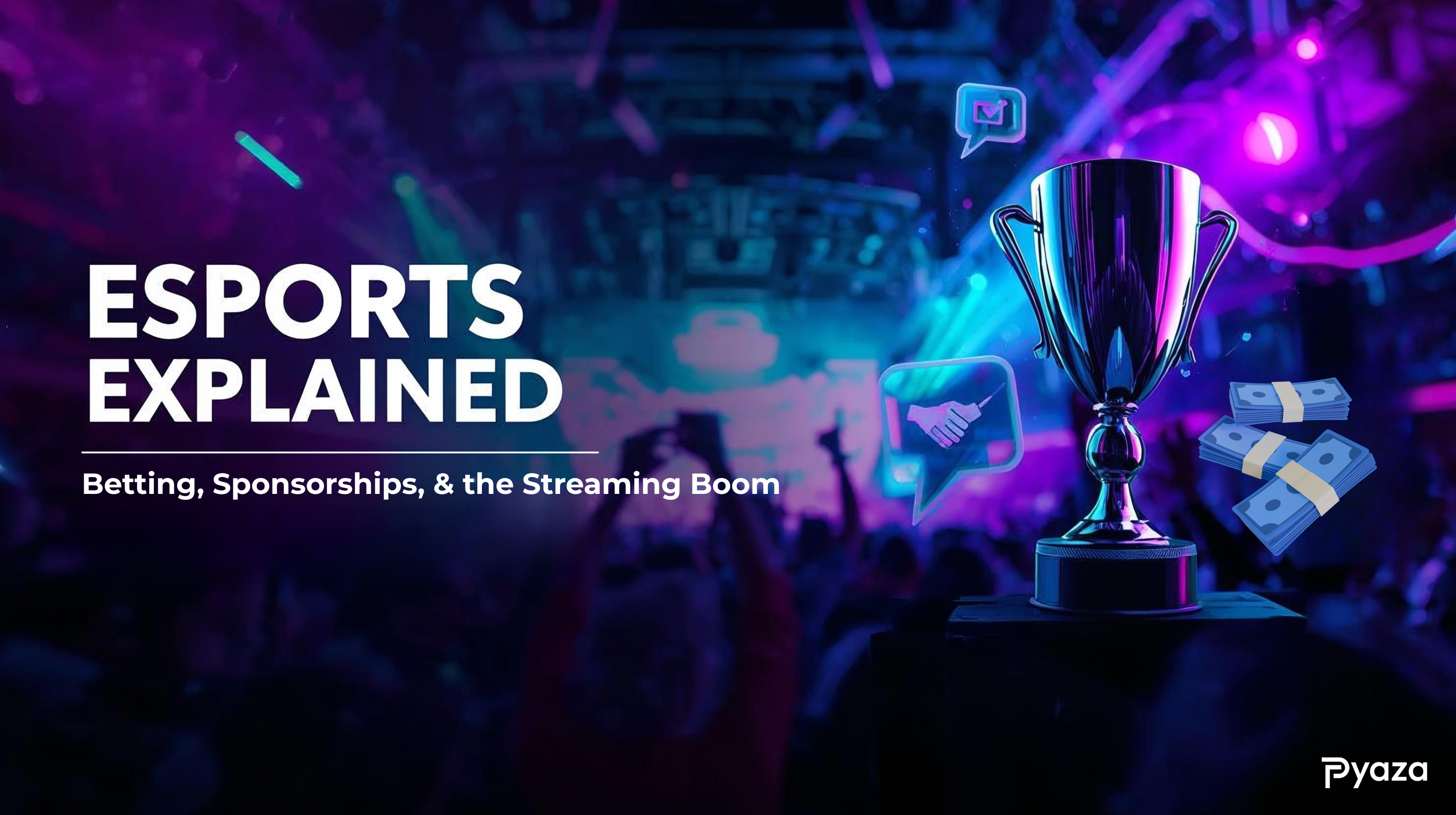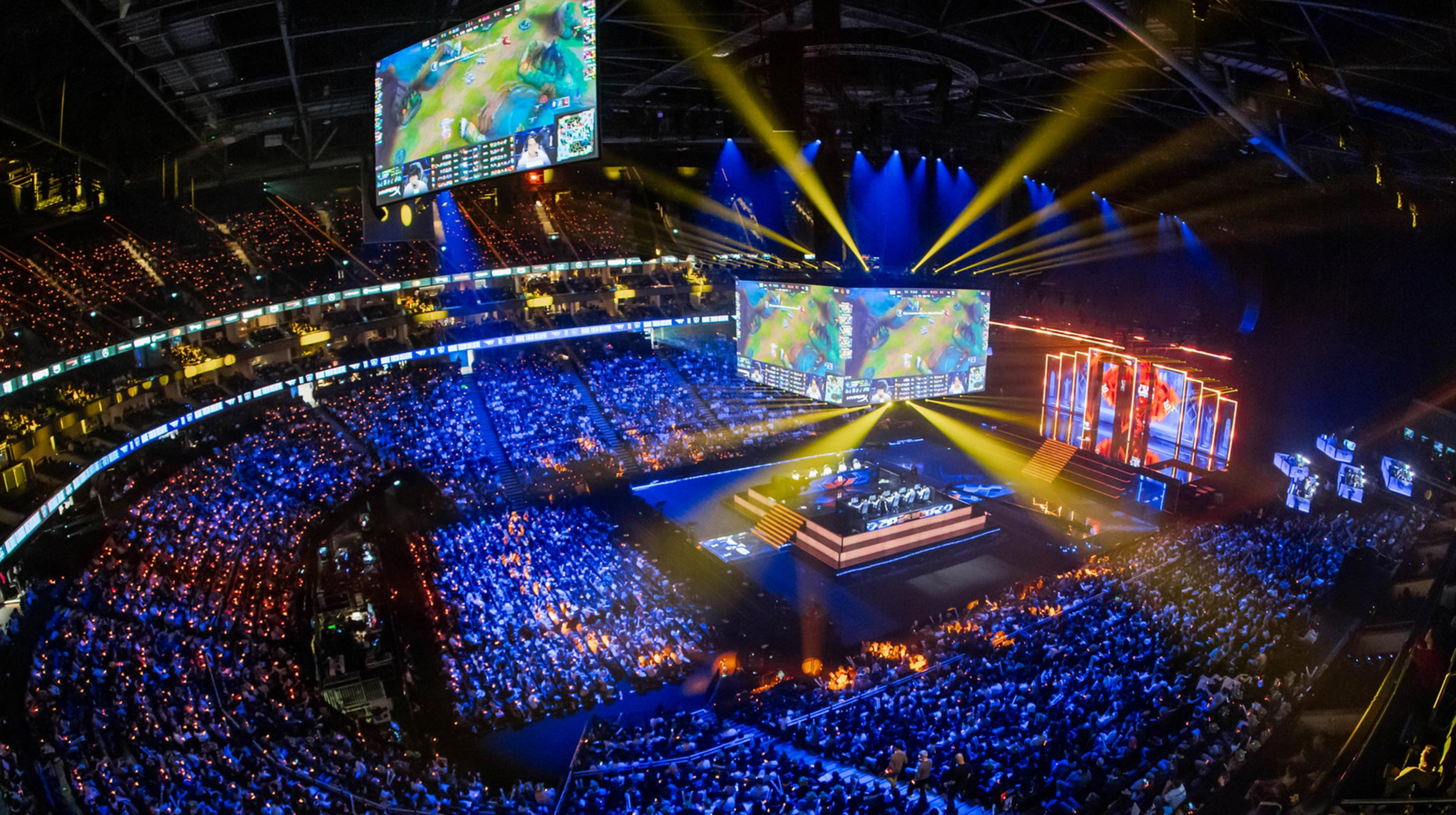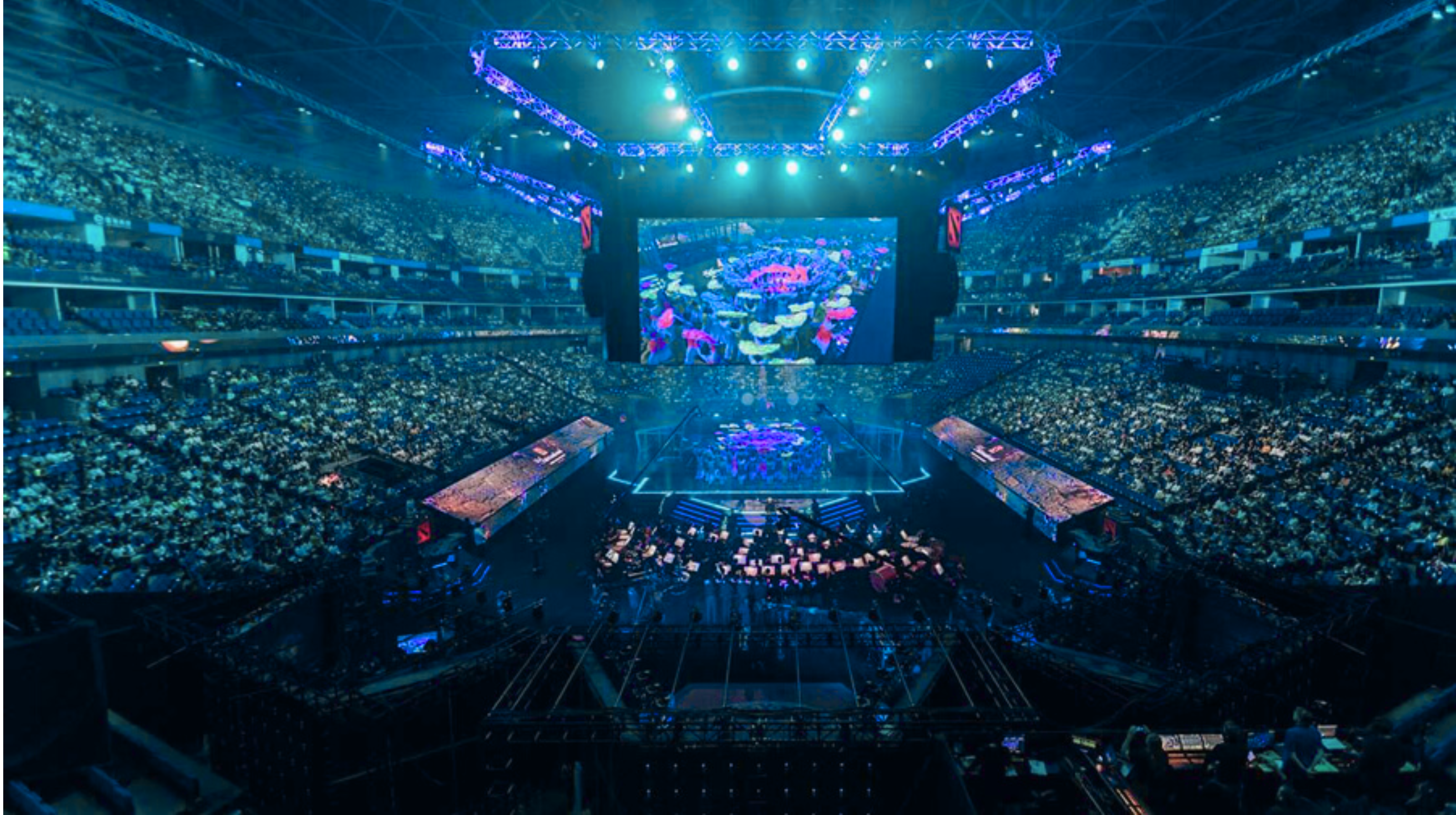Esports Growth Explained
Betting, Sponsorships, and the Streaming Boom
)
Miguel Spiteri
Marketing Manager - Pyaza
Introduction
Esports Growth, Sponsorships, and the Money Behind Gaming’s Biggest Stage
From Basement Tournaments to Global Arenas
Forget dusty basements and weekend LAN parties, today’s esports tournaments fill arenas, fuel billion-dollar sponsorships, and draw global audiences bigger than many traditional sports. In 2025 the Esports World Cup broke records with over 70 million dollars in prizes, proving gaming isn’t just a pastime, it’s the future stage for entertainment, betting, and brand partnerships worldwide.
What started with small community tournaments for games like StarCraft and Counter-Strike has grown into a professional ecosystem with massive esports tournaments, million-dollar prize pools, and global audiences rivaling traditional sports.
The esports community has grown rapidly thanks to streaming platforms, social media, and the professionalization of teams.

Sponsorships and Brand Partnerships
Sponsorships make up the biggest slice of esports income, bringing in more than half of the industry’s total revenue. By 2025, the global sponsorship market for esports is expected to cross 2 billion dollars, showing just how central big brands have become.
Look at who’s on board; Red Bull has deep ties with teams like Fnatic and Sentinels, putting its logo on jerseys and its cans on every stage. Mastercard backs Riot Games’ biggest League of Legends events, from the World Championship to the Mid-Season Invitational, and even launched the Mastercard Gamer Academy to nurture new talent. Nike has signed high-profile deals with organizations such as T1 and individual stars like Faker, giving esports athletes the same kind of sponsorship treatment we see in football or basketball.
It’s not only energy drinks and sportswear either. Logitech G, Razer, Visa, and even the US Air Force are investing heavily in esports. At the Esports World Cup in Riyadh, more than 200 sponsorship deals were signed. Red Bull alone supported 11 different teams, Logitech partnered with 7, and Razer backed 6.
Teams and players are finding creative ways to activate these partnerships. Team Liquid worked with Blacklyte to launch a co-branded gaming chair. Team Vitality expanded into Southeast Asia and launched its own marketing agency, teaming up with Nescafé to produce lifestyle content. On the player side, Faker has his own branded Razer mouse and continues to represent Nike, Red Bull, and other global companies. These deals aren’t just logos on jerseys, they’re integrated into content, social media, and live activations that reach fans wherever they are.
The Rise of Esports Betting
Alongside sponsorships, betting has become a huge part of the money flow. The average revenue per user was around 33 dollars, and that figure is expected to climb in 2025.
Asia-Pacific markets like China, South Korea, and the Philippines dominate the space, but North America is quickly catching up as more states open up to regulated sports betting. Europe remains another stronghold, with the UK and Nordic countries leading in regulated esports betting markets, while Eastern Europe has built massive fan-driven wagering cultures around Counter-Strike and Dota 2.
Fans bet most heavily on titles such as League of Legends, Dota 2, Valorant, and Counter-Strike 2. Valorant in particular has exploded in betting volume, growing more than 170 percent year over year.
What makes this especially powerful is how it ties into the way fans watch esports. Live betting, in-game wagers, and fantasy-style platforms are layered right into streaming, creating an interactive experience that feels natural to younger audiences who grew up with Twitch and YouTube Gaming.

Biggest Competitions and Rewards
In 2025, esports reached a scale that rivals traditional sports in both prize pools and global viewership.
Esports World Cup – Riyadh, Saudi Arabia
The flagship event of the year, running July to August, featured 2,000+ players from 200 clubs across 25 games. With a record-breaking $70M prize pool, it included $27M for the Club Championship, $38M+ for game-specific titles like League of Legends, Dota 2, and CS2, plus $5M in qualifiers and $450K in MVP awards. The scale outpaced the WNBA’s entire salary pool and rivaled events like Wimbledon.BLAST Premier London Open – Wembley’s OVO Arena
A showcase for Counter-Strike 2, this event drew 7,000+ live fans and nearly 90M online viewers. The £400K prize pool was smaller, but the tournament generated an economic impact of £30M for London, comparable to major tennis or basketball events.Fortnite Championship Series – Lyon, France
The FNCS Global Championship featured an $8M prize pool, up from 2024. Thousands of players competed through qualifiers, proving Fortnite still commands a global audience and remains a cultural force years after its peak.
Why These Stages Matter
Together, Riyadh, London, and Lyon represented the biggest esports stages of 2025. They demonstrated how esports can deliver not just prize money but also cultural impact, economic benefit to host cities, and global visibility for players and sponsors alike. Unlike traditional sports, where growth can be steady but incremental, esports continues to spike upward in audience and investment, setting the stage for an even bigger decade ahead.
The biggest esports teams like Team Liquid, T1, and FaZe Clan generate annual revenues in the tens of millions through sponsorships, merchandise, media rights, and esports prize money. Top esports players can earn six to seven figures annually, combining salaries, winnings, and streaming revenue. While average players earn less, the top tier is competitive with professional athletes in emerging sports.
Comparing Esports to Traditional Sports
The scale of esports in 2025 highlights how far the industry has come. The EWC’s $70M prize pool eclipses many long-established sports leagues. The WNBA, for example, had an estimated $120M in total revenue in 2024 and a combined salary pool smaller than a single esports tournament. Even major tennis events like Wimbledon, which offers a total prize pool of around $60M, are now being matched or surpassed by esports stages.
And it’s not just about money, the supporter base is just as striking. Millions tune in live on Twitch, YouTube, and TikTok, with younger fans spending more time watching gaming streams than traditional sports broadcasts. Esports stages are designed for both in-arena spectacle and global streaming scale, giving them an edge in accessibility.

Esports vs WNBA: Who Has More Momentum?
Betting Markets and Revenue Streams
Esports betting continues its rapid climb. In 2024 the global market generated about 2.5 billion dollars and is projected to hit 2.8 billion in 2025, with expectations to cross 3 billion by 2026. By comparison, the overall U.S. sports betting market was worth nearly 18 billion dollars in 2024 and is forecasted to reach around 20 billion in 2025. Esports is still a smaller slice, but it is one of the fastest growing, especially with younger audiences who prefer digital platforms and live interaction.
The WNBA is also seeing a surge in betting activity. Interest spiked with the arrival of Caitlin Clark, which drove record fan engagement. Sportsbooks reported a 113 percent year-over-year increase in WNBA betting in 2024, and Clark’s MVP odds alone attracted more than half of all MVP bets before her injury. The league’s momentum is undeniable, and women’s sports overall are enjoying their highest visibility in decades thanks to new media deals and expanding fan bases.
Still, the scale remains very different. WNBA betting is measured in hundreds of millions, while esports is already in the multi-billion-dollar range globally. Esports’ advantage lies in its digital-first ecosystem: live betting integrations on Twitch and YouTube, global reach across multiple regions, and a fan base built natively on interactive platforms. Where the WNBA is growing fast within U.S. sportsbooks, esports is growing everywhere, simultaneously, and at a speed that traditional leagues rarely achieve.
Revenue and Viewership
The WNBA is on an upward trend. League revenues are projected to approach 1 billion dollars in 2025, up from around 710 million in 2023 and 2024. A new media rights package valued at 200 million dollars annually has boosted the league’s exposure and helped increase player compensation.
Viewership has also grown, with regular-season games averaging around 500,000 viewers and marquee matchups, especially those involving rising stars, crossing the 1 million mark on TV and streaming.
The Esports World Cup 2025 however generated an astonishing 183 million hours watched across 1,700 hours of broadcast content. It secured a 51.3% increase in watch time compared to previous editions, with Mobile Legends: Bang Bang peaking at over 3 million concurrent viewers, while League of Legends topped the charts with a staggering 7.5 million concurrent viewers across platforms, according to Esports Charts.
Esports continues to grow at a global level. Sponsorships from brands like Red Bull, Nike, and Mastercard drive significant revenues, while events such as the Esports World Cup 2025 in Riyadh attracted more than 2,000 players and distributed over 70 million dollars in prize money. Streaming audiences are another major advantage. Millions of fans tune in live on Twitch, YouTube, and TikTok, often choosing esports over traditional TV broadcasts.
To put that into perspective, even with the WNBA’s best growth years, its live audiences are still in the hundreds of thousands. Esports events, by contrast, are drawing millions of simultaneous viewers across Twitch, YouTube, and TikTok. Younger fans are consuming this content on phones, tablets, and PCs, which means esports is building loyalty with the next generation in ways traditional sports are still chasing.
Player Earnings
Average WNBA salaries sit around 120,000 dollars, with star players reaching about 215,000 dollars in salary and bonuses that can push their annual earnings to half a million dollars.
By contrast, top esports players can exceed those figures. Some professionals in titles like Dota 2, League of Legends, and Valorant have earned seven figures in a single year, combining tournament winnings, streaming income, and brand endorsements.
Streaming: The New Stadium for Fans
Streaming has completely reshaped esports, turning it into something that traditional sports can’t easily replicate. Platforms like Twitch, YouTube Gaming, and TikTok Live act as global arenas where millions of fans gather in real time. Unlike traditional broadcasts, streaming is built for interaction. Fans can chat with each other, send reactions, tip their favorite players, and even influence the energy of the match as it unfolds.
What’s more striking is how younger generations are engaging. In the U.S., studies show that more Gen Z and Gen Alpha audiences watch gaming streams than traditional sports broadcasts. They aren’t tied to TV schedules or cable subscriptions. Instead, they’re watching live matches on their tablets during commutes, phones between classes, or PCs at home with friends. For them, esports isn’t just a form of entertainment, it’s a lifestyle woven into their daily digital routines.
Think of streaming as the new stadium. Instead of buying a ticket to sit in the stands, millions of fans log in from anywhere in the world. A League of Legends World Championship can draw tens of millions of concurrent viewers, more than many NBA playoff games. Twitch alone sees over 7 million streamers go live each month, and major events trend across social media as if they were Super Bowls.
For esports, streaming is more than just viewership. It is also a business engine. Sponsors see the direct engagement and invest in advertising campaigns tied to streamers and tournaments. Betting companies leverage streaming’s instant feedback loop to push live odds and in-play wagers. Teams use streaming to build their communities long before fans ever buy merchandise or tickets.
In many ways, esports is already collecting its future audience ahead of time. Kids growing up watching their favorite streamers on YouTube or following esports tournaments on Twitch are forming habits that traditional sports leagues are struggling to build with younger demographics. By the time these viewers are adults, esports will not just be a pastime they discovered in their teens, it will be the sport they have grown up with and stayed connected to.
Streaming has done what stadiums, arenas, and TV rights deals cannot. It has made esports instantly global, endlessly interactive, and deeply personal for fans who feel like they are part of the action rather than passive spectators. That is why streaming is not just a platform for esports. It is the foundation of its future.

Final Takeaway
Looking at the data and trajectory, the esports industry is only scratching the surface of its potential. With sponsorships expanding, esports betting revenue climbing, and streaming esports capturing global audiences, the sector is positioned for massive growth.
Industry forecasts suggest esports revenues could surpass 6 billion dollars by 2030, with streaming audiences expected to double in the same period.
The younger generation’s clear preference for gaming over traditional sports signals that esports will not just complement but rival major leagues in the years ahead. Sports betting, media rights, and new forms of fan engagement will be among the biggest beneficiaries of this unstoppable momentum.
Download the Pyaza APP to follow our coverage, connect with the team, and get involved in upcoming creator campaigns.